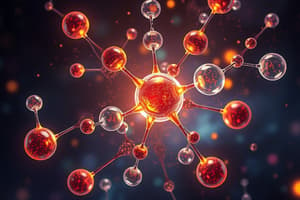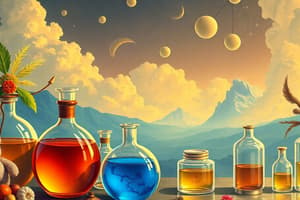Podcast
Questions and Answers
What is the primary focus of organic chemistry?
What is the primary focus of organic chemistry?
- The study of nuclear reactions
- The study of compounds containing carbon (correct)
- The study of all elements in the periodic table
- The study of inorganic compounds
Which of the following best describes the role of medicine men in the early history of organic chemistry?
Which of the following best describes the role of medicine men in the early history of organic chemistry?
- They disproved the theory of Vitalism.
- They developed the first systematic nomenclature for organic compounds.
- They extracted chemicals from plants and animals for medicinal purposes. (correct)
- They synthesized complex organic molecules in a laboratory setting.
What is Vitalism, as it relates to the history of organic chemistry?
What is Vitalism, as it relates to the history of organic chemistry?
- The process of extracting vital medicines from plants.
- The study of vital organs using organic compounds.
- The belief that organic compounds could only originate from living organisms. (correct)
- The synthesis of organic compounds from inorganic materials.
Which scientist is credited with disproving the theory of Vitalism by synthesizing an organic compound from inorganic materials?
Which scientist is credited with disproving the theory of Vitalism by synthesizing an organic compound from inorganic materials?
What chemical was Frederic Wohler trying to create when he inadvertently created urea?
What chemical was Frederic Wohler trying to create when he inadvertently created urea?
Besides undermining Vitalism, what other significant concept was highlighted by Wöhler's discovery?
Besides undermining Vitalism, what other significant concept was highlighted by Wöhler's discovery?
Who are credited with independently developing the theory of chemical structure?
Who are credited with independently developing the theory of chemical structure?
Approximately what percentage of all known compounds are organic?
Approximately what percentage of all known compounds are organic?
Which of the following is NOT listed as a primary source of organic compounds?
Which of the following is NOT listed as a primary source of organic compounds?
What is the defining characteristic of aliphatic hydrocarbons?
What is the defining characteristic of aliphatic hydrocarbons?
What is the literal meaning of the Greek word 'Aleiphar' from which 'aliphatic' is derived?
What is the literal meaning of the Greek word 'Aleiphar' from which 'aliphatic' is derived?
Which type of aliphatic hydrocarbon contains only single covalent bonds?
Which type of aliphatic hydrocarbon contains only single covalent bonds?
What type of bond is present in Alkenes?
What type of bond is present in Alkenes?
What is the general formula for Alkanes?
What is the general formula for Alkanes?
What is the simplest Alkane?
What is the simplest Alkane?
What is another name for ethyne?
What is another name for ethyne?
What suffix in IUPAC nomenclature indicates a triple bond in a carbon chain?
What suffix in IUPAC nomenclature indicates a triple bond in a carbon chain?
Why is the double bond in an alkene not free to rotate?
Why is the double bond in an alkene not free to rotate?
Which statement is most accurate regarding geometric orientation of a cis isomer?
Which statement is most accurate regarding geometric orientation of a cis isomer?
Why don't alkynes display geometric isomerism?
Why don't alkynes display geometric isomerism?
Flashcards
Organic Chemistry
Organic Chemistry
The study of compounds containing carbon, a major branch of chemistry.
Vitalism
Vitalism
The idea that organic compounds originate only from living organisms through vital force.
Isomerism
Isomerism
The possibility of multiple structures from one formula (ammonium cyanate & urea)
Hydrocarbons
Hydrocarbons
Signup and view all the flashcards
Aliphatic Hydrocarbon
Aliphatic Hydrocarbon
Signup and view all the flashcards
Alkanes
Alkanes
Signup and view all the flashcards
Alkenes
Alkenes
Signup and view all the flashcards
Alkynes
Alkynes
Signup and view all the flashcards
Cycloalkanes
Cycloalkanes
Signup and view all the flashcards
Normal Alkanes
Normal Alkanes
Signup and view all the flashcards
Condensed Structural Formula
Condensed Structural Formula
Signup and view all the flashcards
IUPAC Nomenclature
IUPAC Nomenclature
Signup and view all the flashcards
Unsaturated Hydrocarbons
Unsaturated Hydrocarbons
Signup and view all the flashcards
Addition Reaction
Addition Reaction
Signup and view all the flashcards
Geometric Isomers
Geometric Isomers
Signup and view all the flashcards
Study Notes
History and Definition
- Organic chemistry studies carbon-containing compounds and stands as a major branch of chemistry.
- Ancient people extracted chemicals for medicine without formally calling it "organic chemistry."
- Willow bark's pain-killing properties were known, due to acetylsalicylic acid, the active ingredient in aspirin.
- Modern pharmacology is rooted in the knowledge of organic chemistry.
- Jon Jacob Berzelius defined organic chemistry in the early 1800s.
- He classified compounds as organic if from living matter and inorganic if from minerals.
- Berzelius believed in Vitalism, where organic compounds came only from living organisms via a vital force.
- Frederich Wöhler, a student of Berzelius, disproved Vitalism in 1828.
- Wöhler synthesized urea, an organic compound, by heating ammonium cyanate, an inorganic compound.
- Wöhler's synthesis was a turning point, disproving Vitalism and showing organic compounds can come from inorganic sources.
- Wöhler's work led to the discovery of isomerism with ammonium cyanate and urea, both having the formula N2H4CO.
- August Kekulé and Archibald Scott Couper developed the theory of chemical structure in 1858.
- By the 1860s, chemists proposed theories about the relationship between a compound's chemical formula and its atomic arrangement.
- By the 1900s the focus shifted to understanding chemical bonding using electron distribution models.
- Organic chemistry expanded into polymer chemistry, pharmacology, bioengineering, and petro-chemistry in the 20th century.
- Today, over 98% of known compounds are organic.
Matter and Organic Compounds
- Sources of organic compounds are carbonized organic matter, living organisms, and human ingenuity.
- Matter is anything with mass that occupies space.
- Organic compounds are composed of hydrogen, oxygen, and carbon as well as other derivatives
- Organic compounds are characterized by the presence of carbon atoms
- Organic compounds are said to be highly inflammable
Aliphatic Compounds and Hydrocarbons
- An aliphatic compound contains hydrogen and carbon atoms linked in straight chains.
- "Aliphatic" comes from the Greek word "Aleiphar," which means "fat."
- Hydrocarbons have only carbon and hydrogen.
- Hydrocarbons are divided into aliphatic and aromatic types.
- Aliphatic hydrocarbons consist of chains of carbon atoms.
- Alkanes are aliphatic hydrocarbons with single covalent bonds.
- Alkenes have at least one C–C double bond.
- Alkynes have a C–C triple bond.
- Cycloalkanes (or cycloalkenes or cycloalkynes) are aliphatic hydrocarbons with a ring of carbon atoms..
- Alkanes are saturated hydrocarbons with the maximum possible number of hydrogen atoms.
- Alkanes, alkenes, alkynes, and cycloalkanes are hydrocarbons with only carbon and hydrogen.
- They form homologous series where members differ by a CH2 unit.
- The simplest alkanes have straight chains of carbon atoms which are known as normal alkanes.
Alkanes, Alkenes, and Alkynes
- The smallest alkane is methane.
- Methane has a three-dimensional structure, with H atoms at the corners of a tetrahedron.
- Structural formulas show a molecule's structure.
- Condensed structural formulas list hydrogen atoms next to their carbon atoms.
- Line-angle formulas imply carbon atoms at corners and ends of lines.
- Each carbon atom forms four bonds.
- Methane (CH4), ethane (C2H6), and propane (C3H8) begin a homologous series differing by a CH2 unit.
- The general formula for alkanes is CnH2n + 2.
- An alkane with eight carbon atoms has the formula C8H18.
- IUPAC (International Union of Pure and Applied Chemistry) nomenclature is a system for naming hydrocarbons.
- The stem name indicates the number of carbons in the longest continuous chain (LCC).
- Substituents are named with numbers indicating their positions.
- A straight chain of carbon atoms is often called a straight chain due to the tetrahedral arrangement
- Straight-chain alkanes are sometimes called normal alkanes, with the prefix "n-."
- Alkenes are unsaturated compounds containing one or more double bonds.
- Alkynes are unsaturated compounds containing one or more triple bonds.
- An unsaturated hydrocarbon contains less than the maximum amount of hydrogen atoms possible.
- A double bond consists of one sigma (σ) bond and one pi (π) bond.
- A triple bond consists of one sigma (σ) bond and two pi (π) bonds.
- Differing geometries are responsible for the different properties of unsaturated versus saturated fats and oils.
- Ethene (C2H4), or ethylene, is the simplest alkene with a trigonal planar structure.
- Ethyne (C2H2), or acetylene, is the simplest alkyne.
- Carbons in a triple bond have bond angles of 180°, leading to a linear shape.
- The IUPAC nomenclature for alkynes uses the suffix "-yne" to indicate a triple bond.
Naming and Properties
- When naming alkenes and alkynes, the longest carbon chain must contain the double or triple bond.
- Number the main chain so the double or triple bond gets the lowest possible number.
- Ethylene is a key raw material in polyethylene production.
- Ethylene is produced via cracking, breaking long hydrocarbon chains into smaller ones.
- Halogens can add to alkenes and alkynes with mild conditions.
- Hydrogen can be added across multiple bonds via hydrogenation, requiring high pressures and a catalyst.
Isomers
- Geometric isomers (cis-trans isomers) have the same bonding order but different atom arrangements in space.
- Double bonds in alkenes prevent free rotation, allowing geometric isomerism.
- Cis isomers have similar groups on the same side; trans isomers have them on opposite sides.
- Geometric isomers need a rigid structure preventing rotation and two different groups on each carbon.
- Cis-2-butene is polar, while trans-2-butene is nonpolar
- Heat or light can convert geometric isomers by breaking the pi bond and allowing rotation.
- Alkynes display structural isomerism but not geometric isomerism due to only one other group bonded to the carbon atoms in the triple bond.
Studying That Suits You
Use AI to generate personalized quizzes and flashcards to suit your learning preferences.




